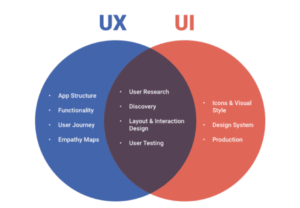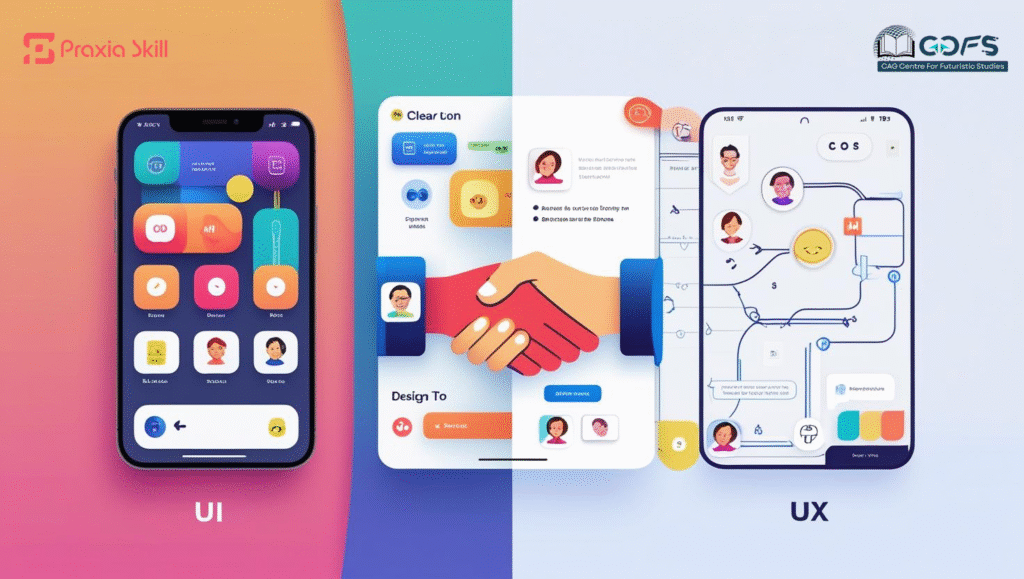Have you ever used an app that was so confusing you wanted to throw your phone? Or, on the flip side, have you ever used a website that felt so intuitive and smooth that you didn’t even have to think about what to do next?
This is the difference between a frustrating digital experience and a delightful one. And at the heart of this difference are two key concepts that are often confused: UI (User Interface) and UX (User Experience).
Don’t worry, you’re not alone if you’ve heard these terms used interchangeably. But understanding what each one does and why they’re so important is the first step toward appreciating great design. So, let’s break it down in a way that’s simple and easy to understand.
What is UI (User Interface)?
Think of UI as the “face” of an app or website.
UI is the visual and interactive part of a product that a user sees and interacts with.
It’s all about the looks! This includes everything from the buttons you click, the text you read, the colours you see, and the way the entire layout is organized.
Key elements of UI design:
- Buttons and Icons: The visual elements you tap or click.
- Colour Schemes: The colour palette used throughout the product.
- Typography: The fonts and text styles.
- Layout and Grids: How all the elements are arranged on the screen.
The job of a UI designer is to make sure the product looks good, is visually consistent, and guides the user’s eye effectively. They focus on aesthetics and the overall “feel” of the design.
UI is like the dashboard and controls of a car. It’s the shiny, beautiful part you see, including the layout of the speedometer, the colour of the buttons, and the design of the steering wheel.
What is UX (User Experience)?
If UI is the face, then UX is the “feel” and the “flow.”
UX is the overall journey, satisfaction, and ease of use a person feels when interacting with a product.
It’s about how the product works. A great UX means a product is not only easy to use but also logical, efficient, and even enjoyable. It’s about solving a user’s problem without them even having to think about it.
Key aspects of UX design:
- Navigation: Is it easy to find what you’re looking for?
- Usability: Can a user complete their goal quickly and without frustration?
- Information Architecture: Is the content organized logically?
- User Research: Talking to people to understand their needs and behaviours.
The job of a UX designer is to research and understand user needs to create a seamless, intuitive, and effective user journey. They focus on the product’s functionality and user satisfaction.
UX is like the entire experience of driving that car. Is the ride smooth? Are the seats comfortable? Can you easily reach the gear shift without stretching? UX is about the comfort, efficiency, and safety of the entire journey.
UI vs UX: The Key Differences
The easiest way to remember the difference is this: UI focuses on how a product looks, while UX focuses on how it works and feels.
|
UI (User Interface) |
UX (User Experience) |
| Focus: Visual and interactive elements | Focus: Overall user journey and functionality |
| Goal: To create a beautiful and consistent UI | Goal: To solve a user’s problem effectively |
| Process: Designing colours, typography, and layouts | Process: User research, wireframing, and testing |
| Output: The final visual design and interactive components | Output: Prototypes, wireframes, and user flow maps |

Why Both UI and UX Matter Together
Imagine a stunning, visually beautiful website (great UI) that has no clear navigation, broken links, and a confusing checkout process (bad UX). You’d get frustrated and leave.
Now, imagine a website that works perfectly and is easy to use (great UX), but looks like it was designed in the 90s (bad UI). You might still use it, but you’d wonder if there was a more modern, trustworthy alternative.
This is why UI and UX are two sides of the same coin. A fantastic product needs both to succeed. The UI is the bridge that connects the user to the UX. The UX makes the product useful, and the UI makes it desirable.
Think of a house. The UX is the architecture and floor plan. It ensures the rooms are logically placed, the hallways are wide enough, and the stairs are safe to climb. The UI is the interior design. It’s the paint on the walls, the furniture, and the decorations that make the house look and feel beautiful. A great house needs both solid architecture and beautiful design.
Common Misconceptions
- “UI and UX are the same thing.” This is the most common misconception. As we’ve seen, they are distinct but complementary fields.
- “Good visuals automatically mean good user experience.” Not at all! A stunning-looking app with a clunky user flow will lead to a bad experience, no matter how pretty it is.
Skills Needed for Each Role
If you’re interested in a career in design, here’s a look at the skills you’d need for each path.
UI Designer Skills:
- Graphic design principles (colour theory, typography)
- Proficiency with design tools like Figma, Sketch, or Adobe XD
- Attention to detail and visual consistency
UX Designer Skills:
- User research and testing
- Wireframing and prototyping
- Problem-solving and critical thinking
- Empathy (the ability to understand a user’s perspective)
Career Opportunities & Getting Started
Both UI and UX design are high-demand fields. You can find entry-level roles like Junior UI Designer or UX Researcher at companies of all sizes.
To get started, you can:
- Read blogs and articles about UI and UX design basics.
- Take free online courses on platforms like Coursera or Skillshare.
- Practice by redesigning an app you already use and creating a portfolio.
Conclusion
So, what’s the difference between UI and UX in one line?
UI is how a product looks, and UX is how it works.
A great product is a perfect blend of both. It looks great and is a joy to use. The next time you use an app or visit a website, try to pay attention to both aspects. Observe the colours and buttons (that’s the UI!) and think about how easy or hard it was to accomplish your goal (that’s the UX!). You’ll be amazed at how much you start to notice.


